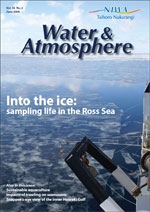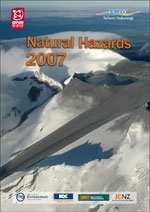PDF of this article (82 KB)


Natural hazards in 2007
From volcano and earthquake to flood, drought, tornado, and tsunami, 2007 was one of the most costly years on record for natural hazards in New Zealand. For the insurance industry, it's projected to be the second most expensive year for natural hazard payouts since 1968, the year of the Wahine storm (exceeded only by the 2004 Manawatu floods). And the Earthquake Commission received three times the number of claims as for the previous year.
The Natural Hazards Centre, a collaboration between NIWA and GNS Science, produces an annual review that describes the major hazard events of the year and the research that goes intoreducing the risks and mitigating the damage of natural hazards.
The 2007 review includes:
- hazards summaries, with graphics and analysis of key events
- reports from the Insurance Council and Earthquake Commission
- hazard planning reports from Ministry of Civil Defence and Emergency Management and Ministry for the Environment
- research summaries from NIWA and GNS Science onweather-related hazards forecasting, geological hazards and society, and a regional RiskScape model.
Copies of the review are available online from the Natural Hazards Centre at www.naturalhazards.net.nz or from Harriet Palmer, 0-4-386 0604, [email protected]
For further information, contact: Doug Ramsay, 0-7-859 1894, [email protected] John Callan, 0-4-570 4732, [email protected]
Volcanoes:
- Mt Ruapehu lahar, 18 March: 1.3 million cubic metres of warm acidic water, entraining five times its weight in rock debris.
- Mt Ruapehu ‘blue-sky’ eruption, 25 September: a boulder seriously injured a climber in Dome Hut about 700 m from the centre of the crater lake.
- Seismic unrest at Mt Ngauruhoe: the volcano has not erupted since 1977, but seismic unrest began in 2006 and is continuing.
Earthquakes:
- 26 earthquakes of magnitude 5.0 or greater: this is about average for NZ
- Gisborne earthquake, 20 December, magnitude 6.8: the year’s worst earthquake and the most damaging since March 1987 Edgecumbe quake (magnitude 6.6).
Landslides:
- Over 100 significant landslides, including a rockfall that killed a climber in Mt Cook National Park in March.
Heavy rain & floods:
- Northland, 28–29 March: now confirmed as a 1-in-150-year event. The heaviest rain fell for over 8–10 hours, with over 40 mm an hour falling in some places.
- Nelson & Taranaki, 22–23 May: schools and businessclosed; houses evacuated.
- Hawke’s Bay, 17–18 July: up to 300 mm rain fell within 48 hours. The army evacuated children from two flooded country schools.
- South Canterbury & Otago, 30 July: heavy rain; state of emergency declared.
Coastal hazards/ tsunami:
- East coast South Island & Cook Strait, 25–26 June: gale-force southerlies with 6 m swells forced ferry cancellations; 8 mwaves at Banks Peninsula.
- Oamaru, June: storm conditions caused localised erosion; factory destroyed.
- Four tsunami recorded, but no resulting damage.
Other weather-related hazards & events:
- Extraordinary swarm of damaging tornadoes in Taranaki, 4–5 July, cut a 140-km-wide swath of damage; state ofemergency declared.
- Driest year on record in many areas. Annual rainfall less than 75% of normal in the east from Wairarapa to Otago, eastern Bay of Plenty, Taranaki, Gisborne, Manawatu, Wellington,and Nelson.
- Lightning strikes on a single night (13 March) cut power to about 40 000 homes in Wellington.
- For the first time since 2001, Central Otago curlers were able to play their sport on the frozen Idaburn Dam (where temperatures fell as low as minus 10 ºC, 17 July). This is despite the fact that the national average temperature for the year as a whole was slightly above normal.
